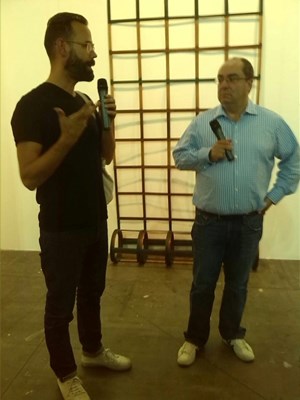
Presented as a series of informal talks, Artissima’s Walkie Talkies bring together one collector and one curator to guide a group, a conversation, through the fair grounds. The Walkie Talkies offer a bit of perspective within the often overwhelming selection of galleries and artworks. And if there’s something that both collectors and curators are familiar with, it’s the practice of selection.
Presented as a series of informal talks, Artissima’s Walkie Talkies bring together one collector and one curator to guide a group, a conversation, through the fair grounds. The Walkie Talkies offer a bit of perspective within the often overwhelming selection of galleries and artworks. And if there’s something that both collectors and curators are familiar with, it’s the practice of selection.
Curator Chris Sharp and collector Pedro Barbosa meet for the first time in order to have this public dialogue. They directed the group towards four different galleries - each choosing two that resonated with their personal interests. Their points of view clashed more often than not - but this just points to the ability of Artissima to encompass a wide range of tastes and aesthetics.
First, Pedro Barbosa led the group to Caroll / Fletcher, showing the work of Basel Abbas and Ruanne Abou-Rahme. This particular installation ticked several of the Brazilian collector’s boxes: he spoke of a fascination towards archival elements and art that is research-driven, in addition to his preference towards artists who are not afraid to venture into multiple mediums. Chris Sharp neatly reminded the group of the question that such art begs us to consider: what does it mean to be a political artist?
The curator’s first gallery choice: Bernard Ceysson Gallery, in the section Back To The Future, showcases a collection of several French painters. Chris Sharp explained his choice as a partiality towards the context of the artworks, created as they were within a movement that centred on an analytical relationship to painting. The movement was doomed to dismantle in a post-’68 environment that suffered under the notion of ‘political guilt’. Pedro Barbosa, however, did not seem convinced - he wondered whether such art focuses too much on form, and Chris Sharp did agree that, indeed, these works are not dealing with narrative.
Chris Sharp’s next location is Bruce Haines, Mayfair, presenting the work of Luisa Gardini, who took a break from her art for over 30 years while she engaged in motherhood. Again, Pedro Barbosa did not think much of the story, arguing that after 30 years of absence the artist had simply picked up where she had left off: whilst the world had changed in those 30 odd years, her style had not. “I think”, Pedro Barbosa argued, “that we have to be extremely dynamic”. As a collector, this is probably his biggest draw. Which is why, if anything sticks out from this walking-talking exercise is his disinterest with compliance: “do not agree with me, because by the time you agree with me, I may have already changed my mind.”
Chris Sharp did not consider Luisa Gardini’s work as stagnant - rather, he argued towards the perfection of craft, which does not necessarily involve expanding in different directions. Instead, it is about nuanced changes. In regards to his own work, Chris Sharp shared his own feeling that he has always been curating the same show in different ways.
The conversation between collector and curator had the chance to conclude on common grounds: a shared appreciation for print. Pedro Barbosa chose the booth of El Astillero as his second, and the final, location. The bookstore’s booth, forming part of Artissima’s Art Editions section, showcases a truly unique collection of Argentinian and South American publications from the early to mid 20th Century. It was only apt, for a conversation on art, to end with the combination of words and images.

ArtDependence Magazine is an international magazine covering all spheres of contemporary art, as well as modern and classical art.
ArtDependence features the latest art news, highlighting interviews with today’s most influential artists, galleries, curators, collectors, fair directors and individuals at the axis of the arts.
The magazine also covers series of articles and reviews on critical art events, new publications and other foremost happenings in the art world.
If you would like to submit events or editorial content to ArtDependence Magazine, please feel free to reach the magazine via the contact page.